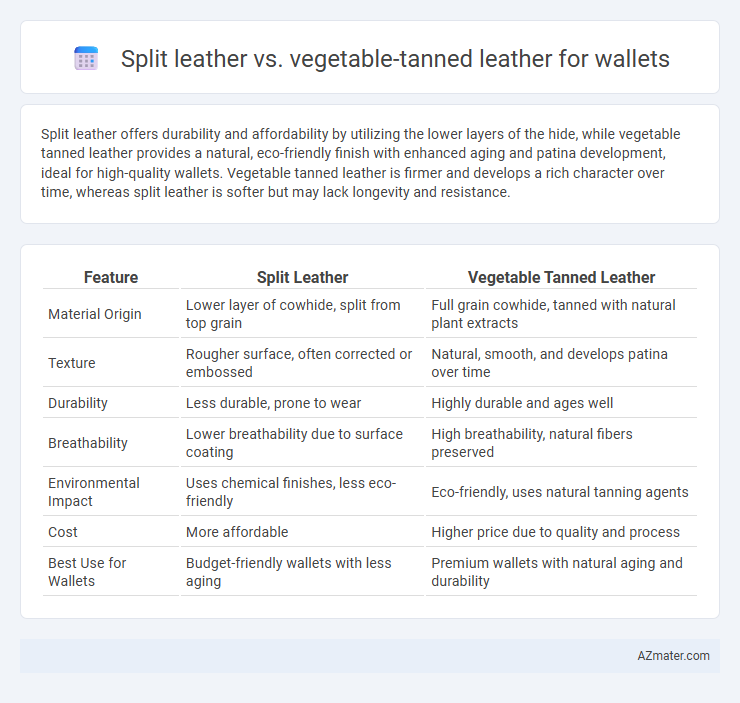Split leather offers durability and affordability by utilizing the lower layers of the hide, while vegetable tanned leather provides a natural, eco-friendly finish with enhanced aging and patina development, ideal for high-quality wallets. Vegetable tanned leather is firmer and develops a rich character over time, whereas split leather is softer but may lack longevity and resistance.
Table of Comparison
| Feature | Split Leather | Vegetable Tanned Leather |
|---|---|---|
| Material Origin | Lower layer of cowhide, split from top grain | Full grain cowhide, tanned with natural plant extracts |
| Texture | Rougher surface, often corrected or embossed | Natural, smooth, and develops patina over time |
| Durability | Less durable, prone to wear | Highly durable and ages well |
| Breathability | Lower breathability due to surface coating | High breathability, natural fibers preserved |
| Environmental Impact | Uses chemical finishes, less eco-friendly | Eco-friendly, uses natural tanning agents |
| Cost | More affordable | Higher price due to quality and process |
| Best Use for Wallets | Budget-friendly wallets with less aging | Premium wallets with natural aging and durability |
Introduction: Understanding Wallet Leather Types
Split leather, derived from the fibrous lower layer of a hide, offers affordability and flexibility but is less durable and less resistant to moisture compared to vegetable tanned leather. Vegetable tanned leather, processed using natural tannins from plant materials, provides superior strength, rich patina development, and enhanced durability ideal for wallets. Choosing between split leather and vegetable tanned leather depends on preferences for longevity, aesthetics, and budget in wallet craftsmanship.
What is Split Leather?
Split leather is derived from the fibrous middle layer of a cowhide after the top grain is separated; it is less durable and often treated with polyurethane or coatings to enhance appearance. Vegetable tanned leather is crafted using natural tannins from tree bark and plants, providing a firmer, more breathable, and eco-friendly material ideal for high-quality wallets. Wallets made from vegetable tanned leather typically exhibit better longevity and develop a unique patina over time compared to those made from split leather.
What is Vegetable Tanned Leather?
Vegetable tanned leather is a natural and eco-friendly material derived from tanning animal hides using tannins found in plant bark, leaves, and fruits. Unlike split leather, which is made from the lower layers of a hide and often artificially treated, vegetable tanned leather retains its full grain, providing durability, a distinctive aging patina, and a firmer texture ideal for high-quality wallets. This type of leather offers superior breathability and develops a rich, unique character over time, making it a preferred choice for premium leather goods.
Durability: Split Leather vs Vegetable Tanned Leather
Split leather typically exhibits lower durability compared to vegetable tanned leather due to its construction from the lower fibrous layers of the hide, making it more prone to wear and damage over time. Vegetable tanned leather undergoes a natural tanning process using tannins from tree bark and plants, resulting in a stronger, more resilient material that develops a unique patina with age. For wallets, vegetable tanned leather offers superior longevity and better resistance to scratches and stretching compared to split leather, making it a preferred choice for high-quality, durable accessories.
Appearance and Texture Comparison
Split leather exhibits a rougher, more porous texture due to its lower grain layer, resulting in a less polished appearance compared to vegetable tanned leather. Vegetable tanned leather offers a smooth, firm surface with rich hues that deepen over time, showcasing natural grain patterns and a luxurious feel ideal for wallets. The durability and aesthetic appeal of vegetable tanned leather make it a preferred option for consumers seeking longevity and a refined finish.
Aging and Patina Development
Vegetable tanned leather ages by developing a rich, deep patina that enhances its character over time, often becoming softer and more supple with use. Split leather lacks the natural grain and dense fiber structure, resulting in less effective patina development and a quicker wear-down without the desirable aging traits. For wallets, vegetable tanned leather provides a more durable, aesthetically pleasing aging process compared to split leather's limited patina formation.
Environmental Impact and Sustainability
Split leather, derived from the lower layers of the hide, often undergoes heavy chemical treatments that increase its environmental footprint, releasing pollutants during production and reducing biodegradability. Vegetable tanned leather employs natural tannins extracted from plant sources like tree bark, minimizing harmful chemical use and enhancing eco-friendliness by producing biodegradable and durable materials. Wallets made from vegetable tanned leather contribute to sustainable fashion through reduced toxic waste, longer lifespan, and potential for environmentally responsible disposal or recycling.
Price Differences and Value
Split leather wallets typically cost less due to the lower grade of leather used, as they are made from the fibrous layers beneath the hide's surface, while vegetable tanned leather wallets command higher prices because of the natural tanning process and durability. Vegetable tanned leather offers better aging potential and patina development, providing long-term value that often justifies the upfront cost. Consumers seeking affordable options may choose split leather, but those prioritizing longevity and aesthetic appeal find vegetable tanned leather a smarter investment.
Ideal Uses: Which Leather for Your Wallet?
Split leather offers durability and affordability, making it ideal for budget-friendly wallets that withstand everyday wear and tear. Vegetable tanned leather provides a rich patina and firm structure, perfect for premium wallets valued for longevity and natural aging. Choose split leather for casual, high-use wallets, and vegetable tanned leather for sophisticated, long-lasting designs.
Final Verdict: Split Leather or Vegetable Tanned Leather for Wallets
Vegetable tanned leather offers superior durability, natural aging, and unique patina development, making it the preferred choice for high-quality wallets. Split leather, derived from the lower layers of the hide, tends to be less durable and often coated to mimic full-grain leather, compromising breathability and longevity. For wallets, vegetable tanned leather delivers enhanced resilience, aesthetic appeal, and long-term value compared to split leather.

Infographic: Split leather vs Vegetable tanned leather for Wallet
 azmater.com
azmater.com